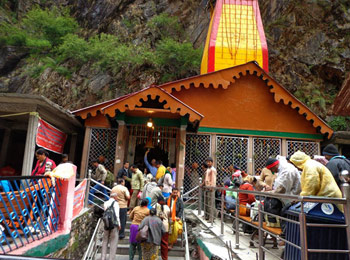- Others
Yamunotri Temple
- Garhwal Himalayas,Uttarakhand
- View on map
- Tell us about this temple
Overview
The Yamunotri Temple is situated in the western region of Garhwal Himalayas at an altitude of 3,291 metres (10,797 ft) in Uttarkashi district, Uttarakhand. The temple is dedicated to Goddess Yamuna and has a black marble idol of the goddess. The Yamunotri temple is a full day's journey from Uttarakhand's main towns — Rishikesh, Haridwar or Dehradun. The actual temple is only accessible by a 13 kilometres (8.1 mi) trek from the town of Hanuman Chatti and a 6 kilometres (3.7 mi) walk from Janki Chatti; horses or palanquins are available for rent. The hike from Hanuman Chatti to Yamunotri is very picturesque with beautiful views of a number of waterfalls. There are two trekking routes from Hanuman Chatti to Yamunotri, the one along the right bank proceeds via the Markandeya Tirth, where the sage Markandeya wrote the Markandeya Purana, the other route which lies on the left bank of the river goes via Kharsali, from where Yamunotri is a five or six hours climb away.
About the temple
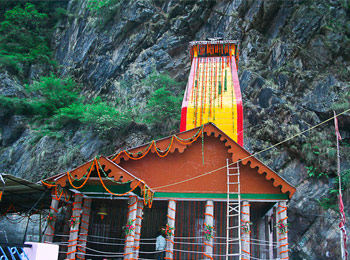
Yamunotri temple has a shrine dedicated to the goddess. There is also an 18th-century temple at Gangotri, it was built by Amar Singh Thapa ,it was damaged and re-innovated in the 19th century. The temple has been destroyed twice by snow and floods before being rebuilt. It is located on the backdrop of Bandarpunch. The temple is part of the revered Char Dham pilgrimage circuit.
The temple opens on Akshaya Tritiya (May) and closes on Yama Dwitiya (the second day after Diwali, November) for the winter. A little ahead is the actual source of the river Yamuna which is at an altitude of about 4,421 metres (14,505 ft) approximately. Two hot springs are also present at Yamunotri offering relief to tired hikers at a height of 3,292 metres (10,801 ft), Surya Kund, has boiling hot water, while Gauri Kund, had tepid water suitable for bathing The spring water is said to be hot enough to cook rice and potatoes. Lodging at the temple itself is limited to a few small ashrams and guest-houses. Ritual duties such as the making and distribution of prasad (sanctified offerings) and the supervision of pujas (ritual venerations) are performed by the Uniyal family of pujaris (priests). Unique aspects of ritual practice at the site include hot springs where raw rice is cooked and made into prasad.
The actual source, a frozen lake of ice and glacier (Champasar Glacier) located on the Kalind Mountain at a height of 4,421 m above sea level, about 1 km further up, is not frequented generally as it is not accessible; hence the shrine has been located on the foot of the hill. The approach is extremely difficult and pilgrims therefore offer puja at the temple itself.The temple of Yamuna, on the left bank of the Yamuna, was constructed by Maharaja Pratap Shah of Tehri Garhwal. The deity is made of black marble. The Yamuna, like the Ganges, has been elevated to the status of a divine mother for the Hindus and has been held responsible for nurturing and developing the Indian civilization.
Legend and stories
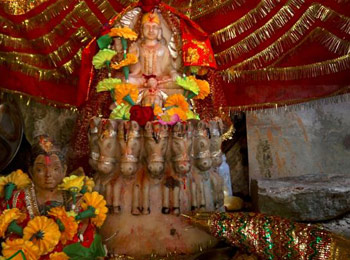
According to the legend ancient, sage Asit Muni had his hermitage here. All his life, he bathed daily both in the Ganges and the Yamuna. Unable to go to Gangotri during his old age, a stream of the Ganges appeared opposite Yamunotri for him.
The temple and the place opens every year on the auspicious day of the Akshaya Tritya, which generally falls during the last week of April, or the first week of May. The temple always closes on the sacred day of Diwali in mid-October - first week of November, with a brief ceremony. The temple staff return to their villages and for the rest of the time the valley is gripped in no-man silence and covered with a white sheet of snow. With the melting of the snow next summer, the temple re-opens.
The daughter of the Sun god, Surya and consciousness, Sangya the birthplace of the Yamuna is the Champasar Glacier (4,421 m) just below the Banderpoonch Mountain. The mountain adjacent to the river source is dedicated to her father, and is called Kalind Parvat, Kalind being another name of Surya. Yamuna is known for her frivolousness, a trait that she developed because, according to a common story, Yamuna's mother could never make eye contact with her dazzling husband.
Festivals
The major festivals celebrated in the Yamunotri region include the following-
Vasant Panchami
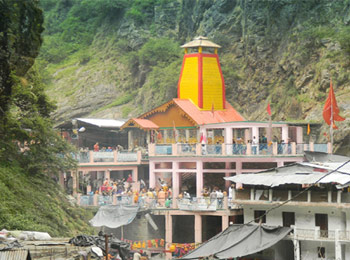
The Vasant Panchami Festival is celebrated during the months January-February. The festivities during this time exhibit a unique admixture of artistic as well as cultural activities and performances. During this festival, devotees offer ‘puja’ to Goddess Saraswati. The festivities of Basant Panchami are associated with the arrival of spring season and the closing of the snowy winter months. During the occasion, people wear yellow clothes, adorn their forehead with Yellow colored Tilak made from Turmeric paste and even use handkerchiefs made from Yellow cloth pieces.
Phool Dei
The festival of Phool Dei celebrated in the month of March, on the very first day is a beautiful festival in which children and young girls mostly participate in the festival rituals. They go to all the houses of the neighborhood with plates adorned with flowers, green leaves, rice, coconut and jiggery. In the yesteryears these items were distributed in Ringal baskets but today it is done with the help of plates or sturdy bags made from plastic. This giving-out of plates bearing these items is a gesture of good will and while doing so, they pray for the health, wealth and prosperity of the neighborhood house to which it is given. In return they are given gifts such as money, jiggery, sweets and lots of blessings. While distributing plates full of the above mentioned items children and young girls also sing out melodies and sprinkle rice, flowers at the neighbor’s doorstep. The neighborhood houses generally collect sufficient rice in that way and this rice is then put to use for making Sai, a mouth-watering rice pudding made from the combination of curd, rice flour, and jiggery. The Phool Dei festival day also signals the start of another very vital religious ceremony-‘Sacred Thread Ceremony’ during which brothers send gifts or Ala to the house of married sisters. Many reputed folk singers gather at Yamunotri during the Phool Dei festival season and enchant everyone with songs of Chaiti, Riturain.
Olgia
The Olgia festival of Yamunotri shows local culture at its best. It is also differently termed as Ghee Sankranti as on the festival day, people generously adorn their forehead with ghee and also consume ghee along with Urad-dal stuffed Chapattis. This festival is celebrated in the month of August when all farms and crop fields are loaded with harvest and when all farm animals are at their productive best. This festival, in other words is a celebration of the flourishing harvest and flourishing prosperity of the land. According to earlier traditions, Nephews and son-in-laws gave gifts to maternal uncles and fathers-in-law respectively on the Olgia day. But today things have changed. These days gifts and good wishes are exchanged between artisans and buyers of their goods and between the farmers and their landlords. Datkhocha or tooth pick made of metal, metal axes, metal calipers, Binai or oral harp, firewood, ghee are the most common gifts exchanged on Olgia day.
If you are planning a trip to Yamunotri, try to arrange the journey during these festive times in order to get the true essence of Yamunotri culture and tradition.
Accommodation
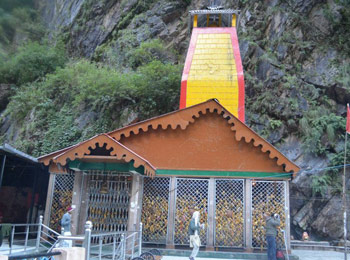
Accommodations in Yamunotri are never a problem and one can easily get a place to take rest during the trip. Dharamshalas are the best option to stay there which provides comfortable stray with best services. This place witnesses large amount of people throughout the year. Some of the hotels in this town are Himalayan Guest House, Hotel Kalindi, Chauhan Tourist lodge, Chauhan Annaxe, GMVN TRH and many more.
Best time to visit
Yamunotri has an all year cold climate. Summers during April to July are pleasant with temperature ranges within 6°C to 20°C and May-June are the warmest months. Winters during October to March are chilly freeze have temperatures at sub-zero level and are characterized by heavy snowfalls. This season is not suited for any outdoor activities, especially December and January. Rainfalls are very scanty here. Basant Panchami held during January–February is a festival which is a blend of cultural and artistic performances. Other festivals celebrated with lots of enthusiasm are Phool Devi during March and Olgia during August. Best periods to visit Yamunotri are during May to June and September to November.
Significance
Yamunotri temple is a significant pilgrimage destination for any pious Hindu. The ‘significance’ of Yamunotri temple can be judged from various angles. Read on to learn more-
Significance from the Religious Point of View
Goddess Yamuna to whom the Yamunotri temple is dedicated is considered as a holy mother figure by her devotees. All Hindu devotees strongly believe that by visiting Yamunotri temple, by praying at the feet of Goddess Yamuna, by getting the privilege to taste the holy ‘Prasadam’ and by taking a holy dip in River Yamuna, they would be able to absolve all their mortal sins and get respite from the ‘fear of death’, the greatest mortal fear. It is a tradition in the temple to cook ‘Prasadam’ from the water of adjoining hot springs. The fuming hot spring water can easily help in cooking rice, pulses and in boiling vegetables. This food is offered to the deity as ‘Prasadam’ and also distributed among devotees. Devotees consider this mineral-enriched Prasadam to be very holy and soul-liberating.
Accessibility
Air
The airport nearest to Yamunotri is Jolly Grant Airport, about 210 kms away from Yamunotri. Daily flight services to Delhi are available at this point. Taxis can be hired to reach Hanuman Chatti from where the trek to Yamunotri begins. One can also avail Helicopter services to reach Yamunotri and such services are available from Dehradun.
Rail
The stations that fall nearest to Yamunotri are Rishikesh, Dehradun. The Dehradun Rail station is 175 kms away from Yamunotri while Rishikesh is 200 kms away and falls on NH 58 prior to Yamunotri. Each of these stations are connected to all major stations of the country through well developed railway networks and trains run quite frequently from all other destination to Rishikesh. There are two other rail stations, not too far away from Yamunotri. Those are Haridwar and Kotdwar. You could reach Yamunotri by taking trains to any of these stations as well.
Road
Motorable roads connect Hanuman Chatti to Dehradun and Rishikesh. Bus, shared jeep, taxi services are available to reach Hanuman Chatti. Bus and taxi for Hanuman Chatti are available from Uttarkashi, Barkot, Tehri Garhwal too. Buses, taxis and other similar vehicles ply between these two stations and Hanuman Chatti via well-developed motorable roads. The most ideal road route to Yamunotri is via Barkot and Dehradun. In case a traveler takes the Haridwar-Rishikesh roadway, the road to reach Yamunotri would divert from the bifurcation point of Dharasu. There are no motorable roads to directly connect Yamunotri but well-developed motorable roads connect Hanuman chatty to other renowned Uttarakhand cities like Dehradun, Uttarkashi, Barkot, Rishikesh, Tehri Garhwal and many more. Taxis and buses ply on these roads regularly, allowing you to reach Hanuman Chatti quite easily. From the ISBT Kashmiri Gate, you would easily get buses to reach Rishikesh.
From Hanuman Chatti, the actual Yamunotri Yatra commences. The most availed pattern of travel is- First 5 kilometers can be travelled by jeep and it will take you from Hanuman Chatti to the Phool Chatti.
From Phool chatti, one has to trek 5 kms to reach Janaki chatty.
From Janaki chatti, again a trek of 8 kms will take you to Yamunotri Dham.
The road head taking you to Yamunotri is connected to Haridwar, Rishikesh and other Uttarakhand cities via well developed bus services arranged by Yatayat Vyavastha Samiti, Samyukt Rotation.
Significance
Devotees visit this temple to seek fulfillment of the following:-
- To be blessed with fertile land
Shlokas
Balam Balavatam Caham Kamaragavivarjitam Dharmaviruddho Bhutesu Kamo'smi Bharatarsabha
Meaning -According to this sloka, God is the isolated and aloof strength of the controlling and virtuous craving in men.
Ye Caiva Sattvika Bhava Rajasastamasasca Ye Matta Everti Tanviddhi Na Tvaham Tesu Temayi
Meaning -According to this sloka, though the only source of satva, rajas and tamas (good, obsessive and dark) elements is God, they are not present within the God or the deity.
Tribhirgunamayairbhavairebhih Sarvamidam Jagat Mohitam Nabhijanati Mamebhyah Paramavyayam
Meaning -According to this sloka, the entire world doesn't recognize the eternal God beyond them, because they are consumed by the elements of satva, rajas and tamas (good, obssessive and dark).
Daivi Hyesa Gunamayi Mama Maya Duratyaya Mameva Ye Prapadyante Mayametam Taranti Te
Meaning -According to this sloka, the heavenly maya of God is very complicated, but those who worship God will be able to overcome it.
